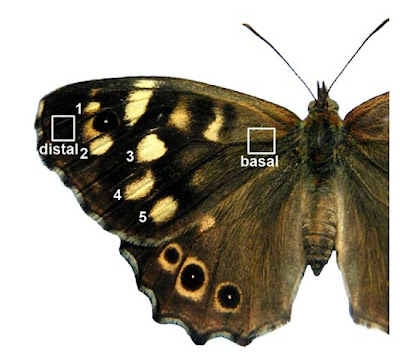
Environmental stress and quantitative genetic variation in butterfly wing characteristics
Evol Ecol (2009) 23:473–485 DOI 10.1007/s10682-008-9246-4
W. Talloen AE S. Van Dongen AE H. Van Dyck AE L. Lens
蝴蝶翅膀特徵廣泛地被用作模式系統使用在發育、數量遺傳與表型可塑性的研究上。然而,雖然在演化上有關聯,選汰壓力對遺傳變異本身表現的影響確很少被研究。在這篇文章中,作者探討斑點木蝶(Pararge aegeria)翅紋特徵的遺傳變異如何隨著寄主植物的乾燥程度梯度而變化。測量部位包括前翅區域、基部與末端的黑化程度以及五個黃色斑紋的區域。作者發現表現在黑化的程度的遺傳變異隨著乾燥壓力的提升而增加,且類似地(雖不顯著),與前翅尺寸相關。結果顯示,狹義“遺傳力(heritability)“的上限、與翅的大小和黑化程度的加成性遺傳變異,都隨著乾燥壓力而上升。不同黃色斑點的樣式則關聯較低,推測存有遺傳變異與環境壓力之間的特徵專一性。
Abstract
Butterfly wing characteristics are extensively used as model system in studies of development, quantitative genetics and phenotypic plasticity. In spite of its evolutionary relevance, however, the effect of stress on the expression of genetic variation itself has only rarely been studied. In this paper, we explore genetic variation of wing characteristics of the Speckled wood Pararge aegeria along a host plant drought stress gradient. Forewing area, basal and distal degree of melanization and the area of five yellow wing spots were measured. We found an increase in (additive) genetic variation in degree of melanization at
higher drought stress, and a similar, yet non-significant, relationship for forewing size. As a result, both the upper limits of the narrow-sense heritability and the coefficient of additive genetic variation of wing size and melanization increased with drought stress. Patterns for the different yellow wing spots were less consistent, suggesting trait-specificity in the relationships between genetic variation and environmental stress.
Evol Ecol (2009) 23:473–485 DOI 10.1007/s10682-008-9246-4
W. Talloen AE S. Van Dongen AE H. Van Dyck AE L. Lens
蝴蝶翅膀特徵廣泛地被用作模式系統使用在發育、數量遺傳與表型可塑性的研究上。然而,雖然在演化上有關聯,選汰壓力對遺傳變異本身表現的影響確很少被研究。在這篇文章中,作者探討斑點木蝶(Pararge aegeria)翅紋特徵的遺傳變異如何隨著寄主植物的乾燥程度梯度而變化。測量部位包括前翅區域、基部與末端的黑化程度以及五個黃色斑紋的區域。作者發現表現在黑化的程度的遺傳變異隨著乾燥壓力的提升而增加,且類似地(雖不顯著),與前翅尺寸相關。結果顯示,狹義“遺傳力(heritability)“的上限、與翅的大小和黑化程度的加成性遺傳變異,都隨著乾燥壓力而上升。不同黃色斑點的樣式則關聯較低,推測存有遺傳變異與環境壓力之間的特徵專一性。
Abstract
Butterfly wing characteristics are extensively used as model system in studies of development, quantitative genetics and phenotypic plasticity. In spite of its evolutionary relevance, however, the effect of stress on the expression of genetic variation itself has only rarely been studied. In this paper, we explore genetic variation of wing characteristics of the Speckled wood Pararge aegeria along a host plant drought stress gradient. Forewing area, basal and distal degree of melanization and the area of five yellow wing spots were measured. We found an increase in (additive) genetic variation in degree of melanization at
higher drought stress, and a similar, yet non-significant, relationship for forewing size. As a result, both the upper limits of the narrow-sense heritability and the coefficient of additive genetic variation of wing size and melanization increased with drought stress. Patterns for the different yellow wing spots were less consistent, suggesting trait-specificity in the relationships between genetic variation and environmental stress.

 PDF (297.5 KB)
PDF (297.5 KB)
沒有留言:
張貼留言